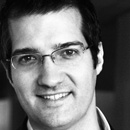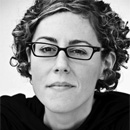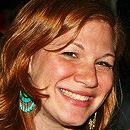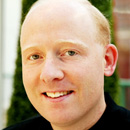Sometimes it’s important to take a step back from reading articles related to user experience and listen to the stories told by those at the forefront of our discipline. So to that end, we sent out a few questions to the speakers of the UX London conference asking them about how they got started and where they see our industry going. We’ve thus far received responses from Stephen Anderson, Dave Gray, Whitney Hess, and Peter Morville—which we’re thrilled to share. Even if you’re not going to the conference, there’s plenty to take away from their responses. Enjoy!
- Experience Design is an extremely broad discipline; how did you guys get involved?
-
Stephen Anderson
My background is in education, but my first formal entry into the UX field was doing Web and graphic design for a dot-com startup. For anyone who has been in a startup environment— especially from the beginning—you know how quickly these pressure cooker environments accelerate your growth. Very quickly, you have to learn a ton of things beyond your job description. In my case, I had to start thinking abut usability, information architecture (before I was aware of the term), and product strategy at a time when many visual designers are just being promoted to art director.
Liz Danzico
There are many early indications that, in retrospect, have led me here: a penchant for organization, a fascination with diplomacy, an appreciation for beauty, a requirement for meaning, and a need for specificity.
Above all, I’d always been interested in the intersection of writing and design; I’d always found a way to keep a hand in both. Growing up in the 1970s, I was certain I’d mature to be a roving travel writer/photographer for National Geographic Magazine, assuming this person both wrote and designed the magazine. She both *had* an experience and *created* an experience. I wanted that. Later on, when National Geographic turned me down for an internship (they suggested I might be better suited as editor), I regrouped my young aspirations and found information design, which eventually led to information architecture and design research.
Dave Gray
I went to art school with the idea that I wanted to do creative work, and at the time I thought that creative work would be a solitary endeavor. But over time I started to understand that the most creative work is social, that involving other people in the design process led to more exciting and more surprising results than working alone. So I found myself gravitating toward more participatory design work. From there UX was a natural next step.
Whitney Hess
I’ve had a rather circuitous route to where I am today. After studying computer science for all four years of high school, I went to Carnegie Mellon University for CS, but quickly discovered that I was more interested in writing English than I was in writing code. I switched majors to Professional Writing (what I like to call “Journalism and more”), but still missed working with technology. A friend of mine told me about our school’s Human-Computer Interaction Institute—a field of study that I had never heard of before—and it was then that I realized that my frustration with computer science had been the focus on making things efficient for the computer instead of making them efficient for the user. I applied for a double-major in HCI, got accepted, and spent the next two years figuring out how to combine my interests in written and visual communication. It was a dream come true. I stayed an extra couple semesters at CMU to get my Master in HCI, and missing my hometown of NYC, jumped at the chance to apply for an Interaction Designer position at Digitas when I saw that they were hiring. The rest is history.
Peter Morville
I arrived at user experience design by way of information architecture, and my academic background is in librarianship. I self-identify as an information architect. And, as a consultant, I serve as a passionate advocate for the critical roles that search and findability play in defining the user experience. My direct contributions to user experience include the UX Honeycomb and the UX Treasure Map.
- What is the most-often overlooked or misunderstood aspect of design and why?
-
Stephen Anderson
That really varies with every client and context. If I had to nail it down to one thing, I think it would be underestimating the importance of design research. We’re all very good—clients and design consultants—at talking about the importance of involving real “users” throughout the process. But once a project starts, it’s easy to just get things done. If you don’t plan (and budget) for user research, it’s the first thing to slip.
Liz Danzico
That it has a beginning and an end, when, in fact, it is emergent. Design has this kind of emergent grammar defined both by those who create it and by those who use and enjoy it—as systems, as products, as services.
Dave Gray
I think a lot of designers still think of design as a more solitary activity and have not gotten excited about the collaboratory, participatory side of design. Most designers are control freaks, and I have to say I am no exception to that general rule. However I have found that the loss of control is offset by the many benefits of collaboration with partners, customers, and so on.
Whitney Hess
The difference between art and design is that design is meant to be used. Design must have a purpose, and its intended purpose should fit an existing need in the world. A lot of people believe that innovation comes from creativity, and that creativity comes from imagination. I believe that creativity in design is expressed through allowing inspiration to grow from a deep understanding of people’s needs.
Peter Morville
In Sketching User Experiences, Bill Buxton argues that we’re responsible for “getting the design right and the right design.” All too often, we latch onto a particular solution and begin the process of incremental improvement without properly exploring the possibility space. As designers, we must work harder to counterbalance the cognitive bias of anchoring. The first idea shouldn’t be the last. And, as individuals and groups, we must get better at divergent thinking. Great ideas are incredibly easy to overlook until they become absolutely obvious and impossible to miss.
- Can you tell us a little bit about your presentation?
-
Stephen Anderson
My short presentation is on “The Art and Science of Seductive Interactions.” I discuss ways you can make your Web site or application a lot more playful and gamelike, using things like curiosity, constraints and other things that engage us emotionally.
My workshop is a somewhat different topic. I’ll talk about creating concept models. This is something I do with clients and for myself, as a way of understanding really difficult ideas— specifically how different parts relate to a whole. For clients, this is a great tool for communication and alignment. Personally, these have surfaced in a variety of infographcis posters I’ve created for the UX community. In the workshop, I’ll share a bit about my process and things to consider when creating these visuals.
Liz Danzico
Sure. It’s something I’ve been thinking about for quite some time.
We explore the balance between consumer and creator — the space where they overlap. And whether implicitly or explicitly, designers are now creating a language that people use to improvise and continue a story.
In recent years with the emergence of new tools, consumers create alongside designers. We’re constantly in a process of re-interpreting, re-analyzing, adding, based on current needs of shared scenarios. And it is these shared exchanges that make new meaning, create new value. How do we plan to create this value? If consumers are now co-creators, how does that change the way we need to be designing?
We look at traditional models of improvisation and specifically focus on six patterns that we can use as design patterns in our own work to facilitate more meaningful work both on the part of our design process and in the work we inspire in those who co-create.
There’s also a workshop on interviewing!
Dave Gray
I’ll be talking about knowledge games, which is a whole toolkit of ideas and practices for collaboration and participatory design. The ideas are part of a book project I am working on that shows people how to engage others in their design process to get more surprising and breakthrough outcomes.
Whitney Hess
I’m running a workshop for UX London called Creating a Culture of UX. I come across a lot of practitioners who are endlessly frustrated because they can’t sell their ideas at work. They’re working full-time at companies that don’t have a user-centered design philosophy and they’re expected to produce without any input from actual customers. I’m hoping that my workshop will teach people how to evangelize a UX practice within their organization and effectively challenge the bad habits of managers and colleagues — essentially to act as internal consultants. And maybe I can inspire a couple people who are getting nowhere to go some place where their skills and passion would be more appreciated and valued.
Peter Morville
I’ll be hitting the highlights from our new book about the present (and future) of search and discovery. I’ll define a pattern language for search and discovery that embraces user psychology and behavior, cross-channel information architecture, multisensory interaction, and emerging technology. And then identify design principles that apply across the categories of web, e-commerce, enterprise, desktop, mobile, social, and realtime. Finally, I’ll explain how future methods and user experience deliverables can help us to create better search interfaces and applications today, and invent the improbable discovery tools of tomorrow. Sound like a lot of ground to cover in 45 minutes? It is. Make sure you’re fully caffeinated!
- In your opinion, how much of design is intuition? how much is learned?
-
Stephen Anderson
I think you could ask this same question of any field— how much can be taught and how much requires some innate, natural talent? If you’re in a leadership role or a position of influence, then you certainly need a different kind of mindset that allows you to see the system as a whole and synthesize new solutions when asked to choose between options. This mindset applies to all forms of design— whether your canvas is pixels or people.
All that said, there is certainly both an art and science to design. I tend to focus more on the science side of things, discussing how an understanding of psychology can help us change subjective design discussions (“I don’t like the color green”) to something objective (“the color green showed a higher conversion over other options”). That said, there will always be a big part of design that is an intuitive leap of faith— that voice that says “I know this will work!” I’d add that all kinds of innovations—from sticky notes to a new UI patterns— emerged from some happy accident or misunderstanding. Being a highly analytical personality, it’s easy to get stuck in a rut of “this is the best way to do things.” I”m always re-energized by folks who break down my notions of what’s “best” with some new— and successful— solution.
Liz Danzico
If you mean on the part of the person who is using a system of design, then
One would hope that more and more, we are building frameworks that allow people to use designs based on intuition rather than new learning. I’ve always liked Christopher Alexander’s Oregon Experiment here to illustrate intuitive behavior, and what we, as designers, can gain and learn from it. In that case, desirepaths — pedestrians creating their own paths through the grass, demonstrating where they desire sidewalks to be — are a visible and outward expression of their intuition.
Dave Gray
You have to have the passion and desire to make the world a better, more beautiful, more meaningful place. If you have the fire the rest will come in time. But nobody is born a great designer. It takes hard work. So I have to say that you need the passion but a that you spend a lot of time learning how to tap into those pools of natural inspiration that everyone has inside.
Whitney Hess
Design principles can be learned over time, and the more experience you have the quicker you become at making good instinctual choices. But intuition can only take you so far. No one knows all of the answers no matter how much of an “expert” they are, and there’s no such thing as a one-size-fits-all solution to every problem. A true designer is only satisfied with their work once the intended audience’s needs are met, and that can only be determined by soliciting feedback and observing its use. It’s a combination of gut and reasoning, but ultimately I think good design is highly rational and the product of iteration.
Peter Morville
In my experience, intuition is a learned behavior. When you’ve spent sufficient time doing (or thinking about) an activity, you learn to feel your way. A particular design just feels right. In part, this is what separates the novice from the expert. I certainly rely on intuition when designing an information architecture. However, I’m also pretty good at inventing rational explanations after the fact. I rarely ask my clients to trust my gut.
- What book(s) are you presently reading?
-
Stephen Anderson
What am I not reading?! I’ve just started Thank You for Arguing: What Aristotle, Lincoln, and Homer Simpson Can Teach Us About the Art of Persuasion. It’s a really fun introduction to rhetoric. I’m also reading several books that discuss game design (for the record, I think that’s a big next evolutionary step for interaction design). For a fun diversion, I’m reading Cory Doctorow’s Down and Out in the Magic Kingdom. It’s a great “post-cyberpunk” story and also where the term “whuffie” comes from.
Liz Danzico
The Search for Time by Dan Falk, and just finished Proust was a Neuroscientist by Jonah Lehrer.
Dave Gray
Right now it so happens I’m reading the Qur’an, which, aside from being a sacred religious text for about 1.5 billion people, is a rich deep, textured, multi-layered work of art. It’s like nothing else I have ever read, and it’s hard to put down.
Whitney Hess
Prototyping: A Practitioner’s Guide by Todd Zaki Warfel and Neuro Web Design: What makes them click? by Susan Weinschenk
Peter Morville
I recently finished Content Strategy by Kristina Halvorson. Great book! I’m currently devouring Eating Animals by Jonathan Safran Foer and The Girl Who Played with Fire by Stieg Larsson. Oh, and The Hunger Games by Suzanne Collins. I’m reading that to our daughters. They love it!
- What new form of interaction are you most looking forward to?
-
Stephen Anderson
Definitely anything multi-touch. In truth, I’d love to do some work with hardware products—medical devices, car dashboards, interactive art displays. I think this would be an exciting new challenge, having spent most of my time working on desktop software and Web apps.
It is interesting to note how after a time, with advances in technology, some of the experiences we design for become less tangible and more ephemeral. No one talks about their “experience” driving through a toll road (where an RFID tag that automatically deducts change from an account), yet this “experience” is far better than any that tangible interaction that might have been designed. Someone could have focused on designing a better tollbooth experience— bigger baskets, wider lanes, prettier tollbooth. Instead, the experience designed is a passive one that—done right— we should never notice.
Liz Danzico
Meeting people face to face for the first time at UX London!
Dave Gray
I’m really looking forward to the face-to-face interactions I will be having in London! But if we’re talking about tech, I have to say I am very excited about ubiquitous computing and how it will change our interactions in urban environments, and in the near term I can’t wait to get a look at the next generation of tablet computers.
Whitney Hess
The realization of ubiquitous technology in the home.
Peter Morville
I’m fascinated by the promise of multi-sensory search. Already, on the iPhone, we can search by singing or by sketching. How long until we can ask Google for something that smells like or tastes like or feels like this? Of course, it might be a bit risky to hit the old I’m Feeling Lucky button.
That’s a wrap!
Thanks to the speakers of UX London for taking the time away from their busy schedules to share their insights. We’ve sent the questionnaire out to everyone involved, so if we receive responses from the other speakers, we’ll be sure to update this post. If you’ve got a question for the speakers, or just want to share your thoughts on the same questions, weigh in below!
You might be wondering…
Curious who these people are or what UX London is all about?
Stephen Anderson

Stephen P. Anderson is an independent consultant based out of Dallas, Texas. He spends an unhealthy amount of time thinking about user experience design and intrapreneurial teams—topics he also speaks about at various national and international events.
Stephen is currently creating the Mental Notes card deck to help product teams apply psychology to interaction design.
Liz Danzico

Liz Danzico is part designer, part educator, and part editor. She is chair and co-founder of the MFA in Interaction Design Program at the School of Visual Arts. She is an independent consultant in New York and user experience consultant for Happy Cog, on the editorial board for Rosenfeld Media, columnist for Interactions Magazine, and on the board of Design Ignites Change. Liz has been adjunct faculty at the New School University and the Fashion Institute of Technology, and lectures widely.
Dave Gray

Dave Gray is the founder and chairman of XPLANE Corp., an information design consultancy serving Fortune 100, NGO and government clients around the world. An artist, journalist and information designer, he is passionate about applied creativity.
Whitney Hess

Whitney Hess is a user experience design consultant based in New York City. She helps make products easy and pleasurable to use. Whitney is a strategic partner with Happy Cog and consults with startups and major corporations, and everyone in between. She writes about technology and customer experience on her blog, Pleasure and Pain, and can always be reached on Twitter @whitneyhess.
Peter Morville

Peter Morville is a writer, speaker, and consultant. He is best known for helping to create the discipline of information architecture. His bestselling books include Information Architecture for the World Wide Web and Ambient Findability. Peter’s latest book, Search Patterns, is being published by O’Reilly Media in 2010. Peter lives in Ann Arbor, Michigan with his wife, two daughters, and a dog named Knowsy. He blogs at findability.org.
What is UX London?

UX London is a unique three-day event combining inspirational talks with in-depth workshops presented by some of the industry’s biggest names.
Whether you’re beginning your career, or a seasoned professional, UX London is your chance to add core skills, absorb strategic thinking, and learn advanced techniques from pioneers in the field.